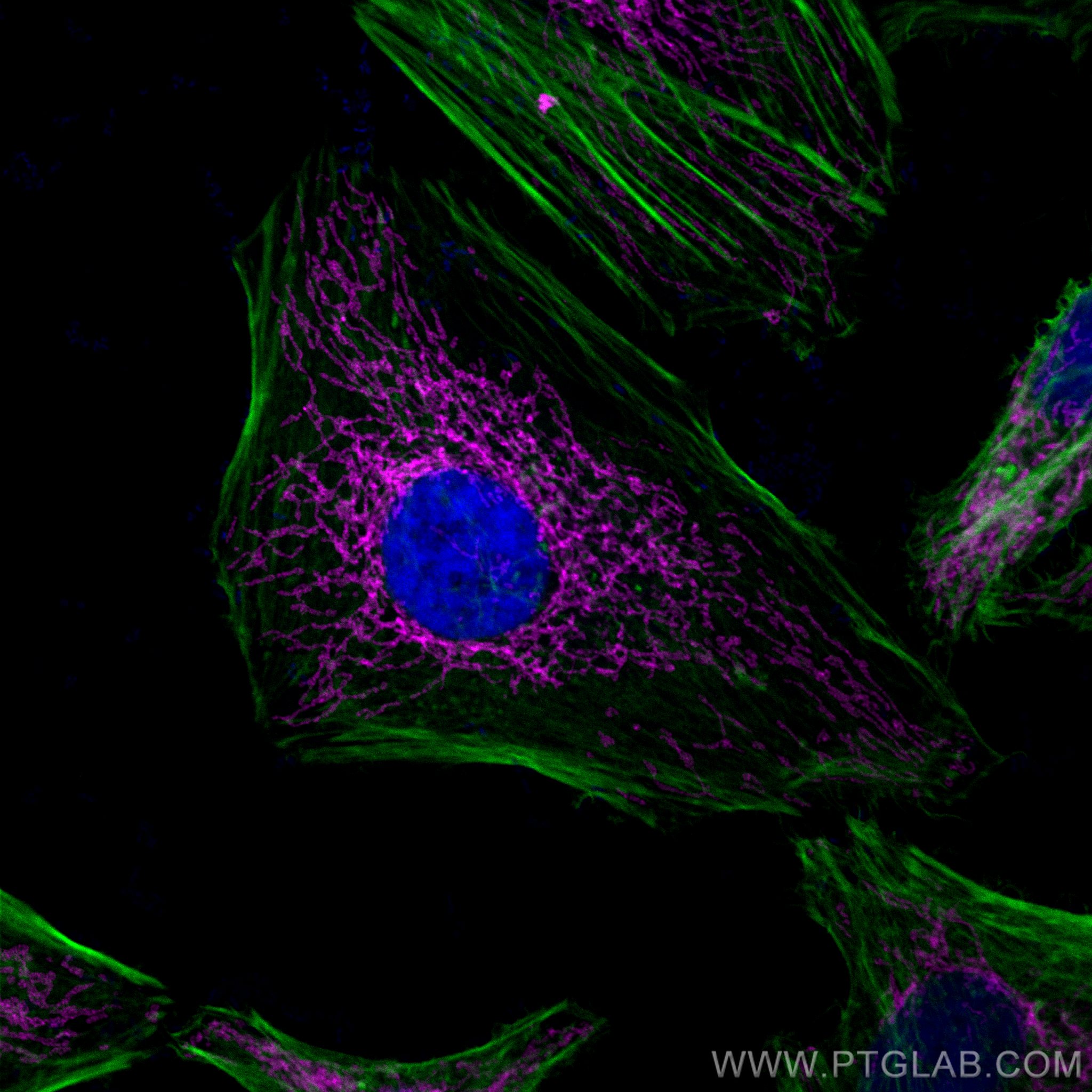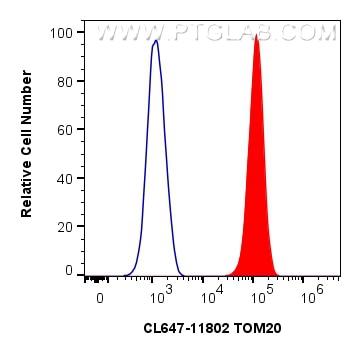- Featured Product
- KD/KO Validated
TOM20 Polyklonaler Antikörper
TOM20 Polyklonal Antikörper für IF/ICC, FC (Intra)
Wirt / Isotyp
Kaninchen / IgG
Getestete Reaktivität
human, Maus, Ratte
Anwendung
IF/ICC, FC (Intra)
Konjugation
CoraLite® Plus 647 Fluorescent Dye
Kat-Nr. : CL647-11802
Synonyme
Geprüfte Anwendungen
| Erfolgreiche Detektion in IF/ICC | HeLa-Zellen |
| Erfolgreiche Detektion in FC (Intra) | HepG2-Zellen |
Empfohlene Verdünnung
| Anwendung | Verdünnung |
|---|---|
| Immunfluoreszenz (IF)/ICC | IF/ICC : 1:50-1:500 |
| Durchflusszytometrie (FC) (INTRA) | FC (INTRA) : 0.80 ug per 10^6 cells in a 100 µl suspension |
| It is recommended that this reagent should be titrated in each testing system to obtain optimal results. | |
| Sample-dependent, check data in validation data gallery | |
Veröffentlichte Anwendungen
| IF | See 5 publications below |
Produktinformation
CL647-11802 bindet in IF/ICC, FC (Intra) TOM20 und zeigt Reaktivität mit human, Maus, Ratten
| Getestete Reaktivität | human, Maus, Ratte |
| In Publikationen genannte Reaktivität | human, Maus, Ratte |
| Wirt / Isotyp | Kaninchen / IgG |
| Klonalität | Polyklonal |
| Typ | Antikörper |
| Immunogen | TOM20 fusion protein Ag2378 |
| Vollständiger Name | translocase of outer mitochondrial membrane 20 homolog (yeast) |
| Berechnetes Molekulargewicht | 145 aa, 16 kDa |
| Beobachtetes Molekulargewicht | 16 kDa |
| GenBank-Zugangsnummer | BC000882 |
| Gene symbol | TOM20 |
| Gene ID (NCBI) | 9804 |
| Konjugation | CoraLite® Plus 647 Fluorescent Dye |
| Excitation/Emission maxima wavelengths | 654 nm / 674 nm |
| Form | Liquid |
| Reinigungsmethode | Antigen-Affinitätsreinigung |
| Lagerungspuffer | PBS with 50% glycerol, 0.05% Proclin300, 0.5% BSA |
| Lagerungsbedingungen | Bei -20°C lagern. Vor Licht schützen. Nach dem Versand ein Jahr stabil. Aliquotieren ist bei -20oC Lagerung nicht notwendig. 20ul Größen enthalten 0,1% BSA. |
Hintergrundinformationen
Background
TOM20 (KIAA0016) belongs to the Tom family. It is a subunit of the mitochondrial import receptor (PMID: 7584026), whose main role is to translocate cytosolically synthesized mitochondrial proteins through the outer mitochondrial membrane and subsequently facilitate the movement of proteins into the TOM40 translocation pore complex (PMID: 21173275).
What is the molecular weight of TOM20?
It is a short 16.3 kDa protein containing several highly conserved regions, including the transmembrane segment, the ligand-binding domain, and flexible segments at the N terminus and the C terminus of the protein crucial for its function (PMID: 15733919).
What is the subcellular localization of TOM20?
It specifically localizes in the mitochondrial outer membrane. In malignant cells, strong granular staining in the cytoplasm has been observed.
What is the tissue specificity of TOM20?
It is ubiquitously expressed in various tissues, with a particularly high expression in the brain, thyroid, and pancreas.
What is the function of TOM20 in the mitochondrial membrane?
Mitochondrial preproteins are generally synthesized in the cytoplasm with signal or targeting sequences, which are recognized by specific receptors on the outer mitochondrial membrane. TOM20, as one of the components of the TOM40 complex, specifically recognizes pre-sequences on target proteins or their unfolded forms. In addition to its translocase activity, TOM20 may act as a chaperone preventing these proteins from aggregation at the surface of mitochondria (PMID: 14699115).
What is TOM20's involvement in disease?
Diseases linked to the misregulation of TOM20 include Perry Syndrome and neurodegeneration with brain iron accumulation 2A. Numerous studies also associate deregulation of TOM20 with an array of mitochondrial dysfunctions and mitophagy defects (PMIDs: 30254015, 30160596).
Protokolle
| PRODUKTSPEZIFISCHE PROTOKOLLE | |
|---|---|
| IF protocol for CL Plus 647 TOM20 antibody CL647-11802 | Protokoll herunterladen |
| STANDARD-PROTOKOLLE | |
|---|---|
| Klicken Sie hier, um unsere Standardprotokolle anzuzeigen |
Publikationen
| Species | Application | Title |
|---|---|---|
Cell Stem Cell Mechano-oncogenic cytoskeletal remodeling drives leukemic transformation with mitochondrial vesicle-mediated STING activation | ||
Brain Res Bull Tas2r123-associated mitochondrial organization and neuroplasticity underlying the antidepressant effect of resveratrol | ||
Nat Cardiovasc Res Correcting mitochondrial loss mitigates NOTCH1-related aortopathy in mice | ||
Adv Mater Signal Converter-Based Therapy Platform Promoting Aging Bone Healing by Improving Permeability of the Mitochondrial Membrane | ||
Adv Mater Functionalized Nanozyme Microcapsules Targeting Deafness Prevention via Mitochondrial Homeostasis Remodeling | ||
Nat Metab Glucose limitation protects cancer cells from apoptosis induced by pyrimidine restriction and replication inhibition |
Rezensionen
The reviews below have been submitted by verified Proteintech customers who received an incentive for providing their feedback.
FH Pierre (Verified Customer) (09-26-2025) | Weak, not so specific ?
|



